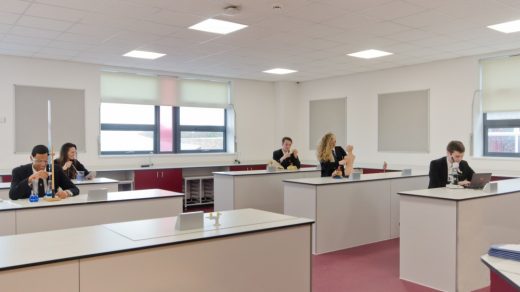Bouldering: The best kid-friendly sport you’ve never heard of

As we return to a normal way of life in the aftermath of the pandemic, it is perhaps more important than ever to find fun and interesting ways for children to get some exercise.
Could a niche form of indoor climbing be your child’s new favourite sport? Youth climbing coach, Jay Railton, discusses the kid-friendly sport you may have never heard of.
The timeline for the UK’s post-COVID recovery has been laid out, and we can finally see a light at the end of the tunnel, particularly for the health and wellbeing of our children. Because while the virus was most dangerous to older or more vulnerable people, an entire generation of young people have been adversely affected in a less direct way.
Forced to remain at home for extended periods, the fitness and general mobility of children has hit an all-time low. Figures published by Sport England show the majority of young people failed to meet the recommended 60 minutes of daily exercise in the 2019/20 academic year.
Sport England CEO, Tim Hollingsworth, said: “The pandemic has had a huge impact on children and young people’s engagement in sport and physical activity.
“While we are pleased to see the increase in more informal activities such as walking and cycling, which were possible during the periods of restriction, we can’t underestimate the long-term effect on other sporting activities both in and out of school.

“Schools play a vital role in keeping young people active – and it’s imperative they’re in a position to facilitate physical activity the moment they can”.
As schools and colleges reopened on 8 March 2021, the fightback begins now: it’s time to get kids moving!
Of course, there are a wide variety of activities to choose from. Choosing the right one can be a minefield. Team sports aren’t for every child, and other outdoor pursuits or watersports can require intensive training up front and a variety of costly equipment.
Bouldering is a rope-free discipline of indoor and outdoor climbing which focusses on lower, but increasingly complex, climbing routes. It is incredibly easy to access but takes a lifetime to truly master. In short: it could be any child’s next obsession.
The physical and mental benefits of climbing are well established. There is a strategic component to climbing which involves assessing the route ahead and planning the most effective moves required to conquer it. Climbing boosts self-esteem and encourages children to face their fears. Every new climb, or ‘problem’ as we call them, provides a reward or sense of accomplishment.
Resilience has never been more of a focus for youth development than it is in the aftermath of the pandemic and it is just one of the values which climbing promotes. That’s why bouldering is so unique because it is so easy to pick up.
The sport requires no harnesses or ropes, and participants don’t need a second person to ‘belay’ them while they climb. All they need is a pair of climbing shoes which are available to rent at most indoor bouldering venues. The Climbing Hangar, for whom I work as a youth climbing coach, provide their rental climbing shoes for free.
Children can attempt climbs on their own, which means their only true competition is with themselves. The aim is to progress. To complete climbs, or even single moves within a climb, which they haven’t completed before. Yet despite being a solo sporting activity, there is a sense of camaraderie that I haven’t found anywhere else. It’s why I fell in love with the sport, myself, as a youngster.
Every new climb begins on the mat and it is on the mat that children socialise with other young climbers, support one another and provide constant motivation. They’re developing climbing skills, and considerable strength, but they’re also developing life skills which they can carry through the rest of their lives.

Bouldering is a gateway to a whole world of adventure. The climbing skills developed at indoor climbing walls can be applied to rock faces all over the UK, Europe and the rest of the world. And in the case of hard-working climbers like Liverpool’s Shauna Coxsey, a fun pastime can become your life’s work.
Shauna was an enthusiastic teenage climber who became The Climbing Hangar’s first ever employee when its first venue opened in 2011. After routinely outclimbing the strongest male climbers in the building she reluctantly tried out for national bouldering competitions and went on to become Britain’s most decorated competitive climber, a multiple time world champion and a member of the GB Olympic squad for Tokyo 2021.
For the first time ever, bouldering will be a part of the Olympic Games competition programme alongside lead climbing (higher, endurance focussed climbs using ropes) and speed climbing (which is effectively sprinting up a wall).
The entire climbing industry expects a windfall of interest in the sport of climbing after the Tokyo Olympics and many are advocating that the sport become a central part of the Physical Exercise curriculum. This doesn’t require schools to build expensive training facilities of their own, as there are a wide variety of excellent facilities all over the UK which coached or teacher lead climbing sessions for school groups.
In providing greater access to climbing sports like bouldering, schools stand a better chance of getting kids moving again. Whilst I might have explained the psychological benefits of bouldering earlier in this article, that should in no way downplay the physical benefits. Climbing is a total body workout which promotes increased core strength, development of the torso muscles that stabilize, align, and move the trunk of the body.
Core strength is essential for developing good posture, and this in turn contributes to the development of children’s motor skills.
Kids don’t need to be the next Shauna Coxsey to benefit from better core strength. A better core is simply essential to a better quality of life. We might have been stuck on our bottoms for too long by the restrictions imposed by COVID-19, but the time for sitting on our bottoms is coming to an end. It’s almost time to get on the wall instead.
Jay Railton is a children’s climbing coach at The Climbing Hangar Liverpool Matchworks.
For more information about the benefits of indoor bouldering visit www.theclimbinghangar.com.



